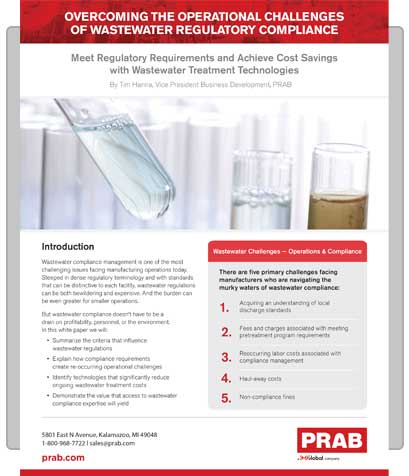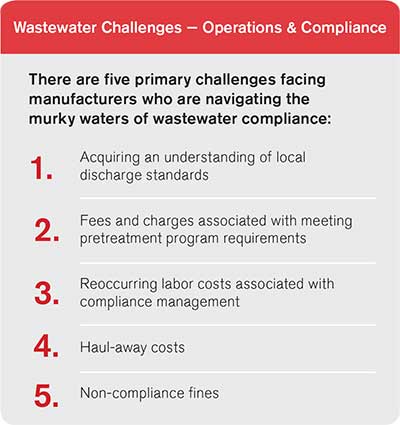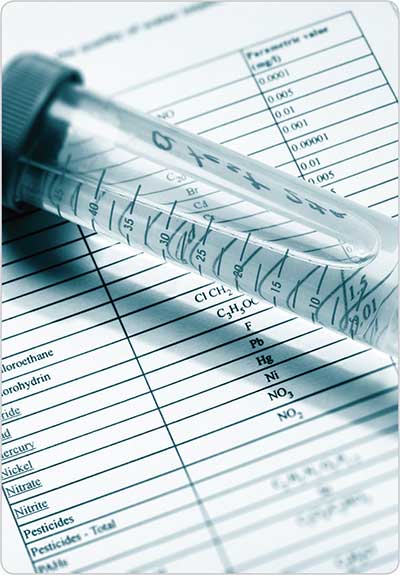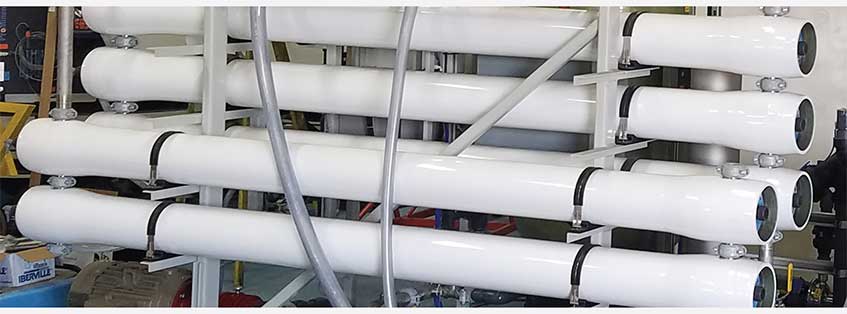

By Tim Hanna, Vice President Business Development, PRAB
Wastewater compliance management is one of the most challenging issues facing manufacturing operations today. Steeped in dense regulatory terminology and with standards that can be distinctive to each facility, wastewater regulations can be both bewildering and expensive. And the burden can be even greater for smaller operations.
But wastewater compliance doesn’t have to be a drain on profitability, personnel, or the environment. In this white paper we will:

There is a fair amount of complexity to wastewater discharge regulations, and lacking a high-level understanding of their framework and enforcement can be a real barrier to effective and efficient compliance management.
Since 1972, the United States has pursued an increasingly stringent water control program. From the Environmental Protection Agency’s perspective, there are two kinds of wastewater discharges that need to be regulated under the Clean Water Act: direct discharges into “waters of the United States” and indirect discharges that pass through a Publicly Owned Treatment Works (POTW) for treatment prior to released back into the water supply. Under the Resource Conservation and Recovery Act, the EPA regulates the transport, treatment, storage, and disposal of solid waste (including oils and sludges).
Indirect discharges are regulated through a national pretreatment program that is a cooperative effort of federal, state, and local environmental regulatory agencies. The objective of the program is to protect POTWs’ infrastructure and to reduce the amount of industrial-generated pollutants that are discharged into the municipal sewer system and the environment.
1. General and specific prohibited discharge standards for all industrial users
2. Categorical pretreatment standards for specific industrial categories2
3. Local limits, which are site-specific and ensure the POTW will not process waste that passes through to the water supply or interferes with operations.
While not a direct component of discharge regulations, Occupational Safety and Health Administration (OSHA) standards also impact an operation’s approach to wastewater management. Hazardous toxic gases can be produced when certain inorganic pollutants in wastewater mix in the discharge collection system. OSHA sets exposure limits to toxic and air contaminants to protect worker health.3 POTWs will reduce this risk by controlling the maximum level of pollutants discharged through the local limits contained in their pretreatment standards.1
If a facility negligently or knowingly operates a source in violation of an applicable pretreatment standard, the penalties are significant:4

Most Industrial Users (IUs) are required to obtain a permit for discharging wastewater from their POTW. At minimum, the EPA requires permits to be issued to all Significant Industrial Users (SIUs), which the EPA defines as:5
The permitting process is usually one of the clearest illustrations that the onus of proactive wastewater compliance falls on the operator. Not only can local wastewater authorities define SIUs in their jurisdiction more stringently, they are counseled by the EPA to communicate pretreatment standards during the permitting process. In a 2012 Industrial User Permitting Guidance Manual6 the EPA states that in its experience,

the permit is the most effective means of ensuring that industrial users are aware of all applicable pretreatment requirements.
Most permit applications require operators to disclose a broad range of details about their wastewater management, such as a description of operations, wastewater generating activities, discharge activities, and the pollutants that may be present in the wastewater and on-site. From the IU’s perspective, it would seem that the operator must supply all the details of its wastewater management practices prior to learning what discharge regulations it will be held accountable to. This approach compromises the operator’s ability to initiate pollution abatement practices that may streamline permit approvals and reduce surcharges levied by the POTW to cover costs for treating wastewater with excessive pollution levels.
After the POTW has issued a permit, there are reoccurring duties that the manufacturing facility must devote time and labor to complete, including:
Many operators have no alternative but to use the services of a liquid waste disposal company to haul and treat their wastewater. Whether by bulk drums or tankers, the costs to transport and treat wastewater are on the rise and will likely continue to trend upward. According to data from the Bureau of Labor Statistics,7 from June 2014 to June 2019 costs for waste collection and remediation services rose 12%.
Achieving wastewater compliance in a cost-effective manner requires a balance of technology and compliance expertise. An ability to work with local control authorities to become familiar with applicable regulations and to adopt measures to meet the regulations is integral.
Furthermore, a thorough understanding of the chemical make-up of the wastewater is needed to determine the most cost-efficient and effective technology for the specific application. Industrial wastewater treatment solutions are not one-size-fits-all. An experienced and trusted supplier of industrial wastewater solutions will evaluate a facility’s previous laboratory analyses of wastewater or recycling streams and explain the appropriate tactics for streamlining the operation’s wastewater compliance management.
The EPA’s Effluent Guidelines3 set technology-based numerical limitations for specific pollutants on an industry-by-industry basis. Pollution reduction is achievable through technology, but the guidelines don’t require the use of a specific technology to achieve reduction. Fortunately, there are several zero-liquid discharge technologies available that can be installed on-site to reduce water pollution, increase the amount of wastewater eligible to be sent to sewer, and even prepare water to be recycled and re-used within the production facility.
Ultrafiltration uses high amounts of pressure to push wastewater through a semipermeable membrane. This filters out organics, emulsified oils, and suspended solids, reducing oily water volumes by as much as 98% without chemicals. Ultrafiltration systems are shown to reduce the cost of washwater and detergents by as much as 75% and reduce haul-away costs by 90%. Ultrafiltration systems can help manufacturing facilities meet their zero manifesting goals and provide them the ability to meet RCRA requirements and state and local discharge regulations.
Reverse osmosis is a low-maintenance method that removes dissolved solids from the wastewater using a semipermeable reverse osmosis membrane. Reverse osmosis technology removes up to 99.5% of dissolved salts and impurities. Often this technology is used as a final process after ultrafiltration or chemical treatment of wastewater.
Vacuum evaporation is one of the most effective methods for mitigating the risks and costs associated with industrial wastewater. This process removes salts, heavy metals and a variety of hazardous components. This method restores 90-95% of the original distillate (water), reduces the cost of washwater and detergents up to 75%, and reduce water costs up to 99%. Vacuum evaporation also has a low-carbon footprint.

Regulatory compliance is the foremost consideration for wastewater management in industrial operations. However, operations that align themselves with experts to establish improved wastewater management practices will realize benefits beyond regulatory compliance, including:
With regulations growing increasingly stringent, taking steps to advance wastewater compliance management now will ease the burden of future restrictions.
1 United States Environmental Protection Agency, National Pollutant Discharge Elimination System, National Pretreatment Program – https://www.epa.gov/npdes/national-pretreatment-program
2 United States Environmental Protection Agency, Effluent Guidelines – https://www.epa.gov/eg/industrial-effluent-guidelines
3 United States Department of Labor, Occupational Safety and Health Administration, OSHA Laws & Regulations – https://www.osha.gov/laws-regs/regulations/standardnumber/1910
4 United States Environmental Protection Agency, Criminal Provisions of the Clean Water Act – https://www.epa.gov/enforcement/criminal-provisions-clean-water-act
5 United States Environmental Protection Agency, Introduction to the National Pretreatment Program – https://www3.epa.gov/npdes/pubs/pretreatment_program_intro_2011.pdf
6 United States Environmental Protection Agency, Industrial User Permitting Guidance Manual, 833-R-12-001A, September 2012 – https://www.epa.gov/sites/production/files/2015-10/documents/industrial_user_permitting_manual_full.pdf
7 Bureau of Labor Statistics, Producer Price Indexes – https://www.bls.gov/ppi/ppi_dr.htm